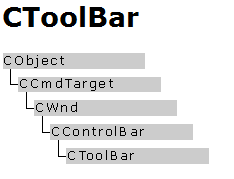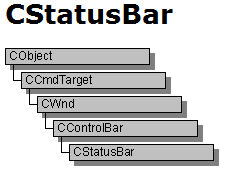MFC学习笔记之七————工具栏编程与状态栏编程

首先来说MFC中工具栏的创建方法,可以有两种方法创建工具栏:
第一种方式的步骤如下:
(1)创建工具栏资源。这个在IDE中的资源编辑器中完成。
(2)构造一个CToolBar对象。
(3)调用Create()函数或者CreateEx()函数创建Windows工具栏,并把它与已经创建好的CToolBar对象关联起来。(两个Create函数是CTollBar的成员函数)。原型看看:
BOOL Create( CWnd* pParentWnd, DWORD dwStyle = WS_CHILD | WS_VISIBLE | CBRS_TOP, UINT nID = AFX_IDW_TOOLBAR ); BOOL CreateEx(CWnd* pParentWnd, DWORD dwCtrlStyle = TBSTYLE_FLAT, DWORD dwStyle = WS_CHILD | WS_VISIBLE | CBRS_ALIGN_TOP, CRect rcBorders = CRect(0, 0, 0, 0), UINT nID = AFX_IDW_TOOLBAR);
参数含义参考MSDN;
(4)调用LoadToolBar函数加载工具栏资源。
如下在CMainFrame类中的OnCreate函数中:
if (!m_newToolBar.CreateEx(this, TBSTYLE_FLAT, WS_CHILD | WS_VISIBLE | CBRS_RIGHT
| CBRS_GRIPPER | CBRS_TOOLTIPS | CBRS_FLYBY | CBRS_SIZE_DYNAMIC) ||
!m_newToolBar.LoadToolBar(IDR_TOOLBAR1))
{
TRACE0("Failed to create toolbar\n");
return -1; // fail to create
}
第二种创建工具栏的方式:
(1)构造一个CToolBar对象;
(2)调用CreateEx或者Create函数创建工具栏,并把它与以创建的CToolBar对象关联起来。
(3)调用LoadBitmap函数加载包含工具栏按钮的图像位图。
(4)调用SerButtons函数设置按钮的样式;原型:
BOOL SetButtons( const UINT* lpIDArray, int nIDCount );
下面说说MFC创建工具栏的过程,在CMainFrame类的OnCreate函数中,首先调用CToolBar类成员函数OnCreateEx()创建工具栏,接着调用LoadToolbar()函数加载工具栏资源,接着CMainFrame类的OnCreate函数调用工具栏对象的父类CControlBar的成员函数EnableDocking()设置工具栏的停靠位置,其可取值表如下:
CBRS_ALIGN_TOP Allows docking at the top of the client area.
CBRS_ALIGN_BOTTOM Allows docking at the bottom of the client area.
CBRS_ALIGN_LEFT Allows docking on the left side of the client area.
CBRS_ALIGN_RIGHT Allows docking on the right side of the client area.
CBRS_ALIGN_ANY Allows docking on any side of the client area.
CBRS_FLOAT_MULTI Allows multiple control bars to be floated in a single mini-frame window.
接下来CMainFrame类的OnCreate函数又调用一个EnableDocking函数,先前第一次调用的EnableDocking()函数是工具俊朗对象(父类中)的成员函数,目的是让工具栏对象可以停靠,而第二次调用的是CFrameWnd对象的EnableDocking()成员函数,目的是让主框架窗口可停靠。停靠表可是上表的前五项组成。
隐藏显示工具栏:
m_newToolBar.ShowWindow(SW_HIDE); m_newToolBar.ShowWindow(SW_SHOW);

接下来是状态栏编程:
我们可以看到在CMainFrame的OnCreate函数中已经有了创建状态栏响应的代码,Indicator[]数组中有状态栏的信息如果要增加,可以在String Table中加入一个IDS_Timer(自定义的状态栏Item的ID),然后将其加入到数组中
if (!m_wndStatusBar.Create(this) ||
!m_wndStatusBar.SetIndicators(indicators,
sizeof(indicators)/sizeof(UINT)))
{
TRACE0("Failed to create status bar\n");
return -1; // fail to create
}
static UINT indicators[] =//indicator数组
{
ID_SEPARATOR, // status line indicator
IDS_TIMER,
IDS_PROGRESS,
ID_INDICATOR_CAPS,
ID_INDICATOR_NUM,
ID_INDICATOR_SCRL,
};
当然我们可以在状态栏中添加一些状态的显示,还有可以加入以下状态显示的控件!比如:CProgressCtrl控件。
要记得最重要的——MSDN!
记录下自己的所学,虽然浅薄!!!如果我是一只蜗牛,那就只能慢慢向上爬!